
The LONDON TRANSPORT RT FAMILY: "PRE-WAR" RTs
This page updated 26th February 2013: best on 800*600.
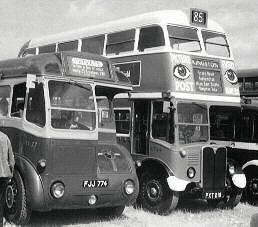
RT2-151 (Total 150)Introduced:1940Chassis: Type 2RT: AEC Regent III, 16ft 4in wheel-base, 6 cylinder 9.6 litre diesel, A185 Bodies: Chiswick, RT2: 56 seats (26 + 30), composite wood-metal frames, 4 bays, 25ft 11 3/8in long, 7ft 6in wide, 14 ft 3 1/2 in high.
Pre-war RT44 keeps TF77 company at a rally in Stratford upon Avon, 1970.
|
| No. | Route | Garage |
|---|---|---|
| 14 | Hornsey Rise - Kings Cross - Picc.Circus - Knightsbridge - Putney - Kingston | F |
| 22 | Homerton - Dalston - St.Pauls - Picc. Circus - Knightsbridge - Chelsea - Putney Common | GM |
| 28 | Golders Green - Kilburn - Kensington - Wandsworth - Putney Heath | AF |
| 30 | Roehampton - Putney - Earls Court - Knightsbridge - Marble Arch - Kings Cross - Dalston - Hackney Wick | AF |
| 37 | Peckham - Herne Hill - Brixton - Clapham Junc. - Putney - Richmond - Hounslow | AF |
| 72 | East Acton - Shepherds Bush - Barnes Common - Roehampton - Hook - Esher | AF |
The War Years
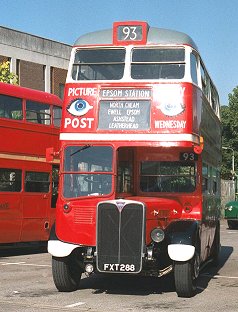
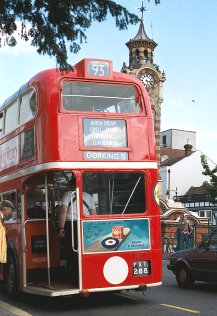 The new RTs were not without their teething troubles.
In particular they had braking problems,
due to the inadequacy of the compressor.
This was a British replacement for the German-made one used on RT1.
These were unobtainable for a while.
Problems with brakes meant that many went into store until they could be sorted out.
Initially the existing rotary compressors were upgraded,
to try to restore the RTs to service.
Later a different type of compressor was found,
a reciprocating pump belt-driven from the gearbox,
which supplied enough compressed air to keep everything working,
and the buses were modified, becoming 1/2RT2/1 in the process.
The new RTs were not without their teething troubles.
In particular they had braking problems,
due to the inadequacy of the compressor.
This was a British replacement for the German-made one used on RT1.
These were unobtainable for a while.
Problems with brakes meant that many went into store until they could be sorted out.
Initially the existing rotary compressors were upgraded,
to try to restore the RTs to service.
Later a different type of compressor was found,
a reciprocating pump belt-driven from the gearbox,
which supplied enough compressed air to keep everything working,
and the buses were modified, becoming 1/2RT2/1 in the process.
The buses returned to Putney and Putney Bridge garages, initially on the 37 and 72, and then the 14. As the situation improved their allocation spread to the 14, 74, 85, 93 and 96 from Putney Bridge, the 30 and 37 from Putney and the 52 at Victoria.
RT113, preserved in wartime livery, worked route 93 from Putney Bridge to Dorking and back, during the September 2002 Dorking Running Day.
October 1941 Routes:| No. | Route | Garage |
|---|---|---|
| 14 | Hornsey Rise - Kings Cross - Picc.Circus - Knightsbridge - Putney | F |
| 30 | Roehampton - Putney - Earls Court - Knightsbridge - Marble Arch - Kings Cross - Dalston - Hackney Wick | AF |
| 37 | Peckham - Herne Hill - Brixton - Clapham Junc. - Putney - Richmond - Hounslow | AF |
| 52 | Victoria - Knightsbridge - Ladbroke Grove - Kensal Rise - Willesden - Burnt Oak - Mill Hill | GM |
| 74 | Camden Town - Zoo - Marble Arch - Earls Court - Putney - Putney Heath | F |
| 85 | Putney Bridge - Roehampton - Norbiton - Kingston | F |
| 93 | Putney Bridge - Wimbledon Common - Morden - Ewell - Epsom | F |
| 96 | Putney Common - Knightsbridge - Picc Circus - Aldwych - St Pauls - Aldgate - Mile End - Stratford - Wanstead | F |
There were some war-time casualties.
Several were caused by the German V1 cruise missiles during 1944.
RT87 and RT52 were badly damaged in June, with the bodies going for repair.
That from RT52 returned to be mounted on RT87,
while the chassis of RT52 was sent to AEC.
Eventually, in March 1945, RT52 was refitted with a body (from RT19),
and returned to service.
RT66 also suffered in June 1944, and its bodied was destroyed beyond recovery.
RT66 took the repaired body ex RT87 when it returned in September.
RT59 and RT97 were damaged in July,
and were sent to Birmingham City Transport for repair.
RT59 returned with minor body oddities, but RT97 came back without repair.
RT97 was then used as a project vehicle.
Fitted with platform doors,
it was used on Central Area
and then Greenline Pay As You Board experiments during 1946.
A further rebuild made it a prototype RT coach: RTC1.
A fuller story is given on a separate page.
Other casualties were less significant: RT110 lost its front roof box,
but continued without it until 1954.
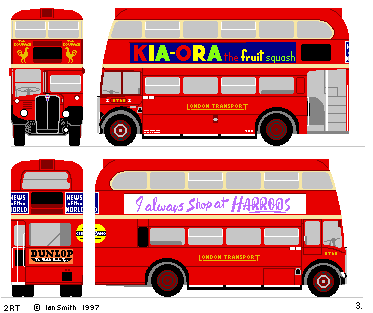
Post-war recovery
After the war it took some time for normality to return. Materials were still in short supply. But the RTs lost their anti-shatter netting and their headlamp cowls, and gained proper headlights and fog-lamps for the first time. Overhauls gradually started to catch up on the maintenance back-log. The first two in March 1946, RT7 and RT39, received red livery with two cream bands, one on the cant-rail and the other above the top deck windows, as did newly-restored RT19. This style did not last long, being superceded by red with cream band and upper-deck window surrounds.Putney, Putney Bridge and Victoria garages continued to be associated with the type after the war.
In July 1952 eighteen were allocated to New Cross (NX) for tram replacement, where they worked alongside some refurbished STLs. These 2RT2s had their blinds restored to full displays (except the rear lighthouse), and received the full red with cream band livery. New Cross garage was still being converted, so the 2RTs actually worked from Peckham garage, but with NX plates and crews. They strayed sometimes onto Peckham's Sunday 70A, wearing PM plates.
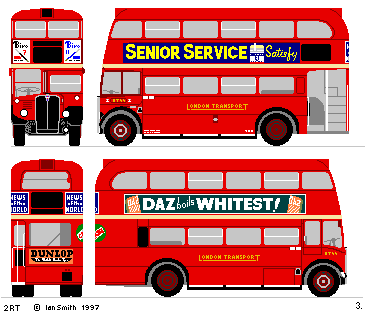
| No. | Route | Garage |
|---|---|---|
| 163 | Victoria Embankment - Westminster Bdg - Camberwell - New Cross - Greenwich - Woolwich | NX (PM) |
| 177 | Abbey Wood - Plumstead - Woolwich - New Cross - Old Kent Rd - Elephant - Westminster Bdg - Victoria Embankment - Blackfriars Bdg - Elephant - - Abbey Wood | NX (PM) |
| 182 | Woolwich - Eltham - Lee Green - Lewisham - New Cross Gate - Old Kent Rd - Cannon Street | NX (PM) |
| 70A | Victoria Embankment - Blackfriars - Southwark - London Bridge - Surrey Docks - Deptford | PM |
2RT2 in post-war red livery.
Staff buses and trainers
In 1955 the 2RT2s were displaced from Central Area passenger service at a stroke. Most survived the blow. The opening of Aldenham works, away at the edge of the London Transport area, and beyond the Tube system, required London Transport to bus in its staff, many of whom previously worked at Chiswick and lived near there. Other workers had previously been at Charlton (the tram works), Lewisham (Tilling's works), Reigate (LGCS Southern division) or St Albans (LGCS Northern). So a network of staff buses ventured across London every day to reach the works, and about sixty of the 2RT2s were used for this. Most of the others became trainers. Some were attached to individual garages for several years, especially in the Country Area and at places where there was a steady demand for training, such as Bromley and Croydon. Others did the rounds, transferring from garage to garage as training required, and being an essential ingredient of the trolleybus conversion programme. They continued in this role for some years, whilst younger 3RT3s were being sold off.
A crunch came in autumn 1959.
Spare RTLs took over the Aldenham staff duties in September and October.
The displaced 2RT2s, with relatively few miles on the clock, took over training duties,
and many of the trainers went into store.
They accumulated at the Stockwell barn,
and then at Camberwell and Walworth, prior to mass sales in 1960.
Most went for scrap, often at Bird's of Stratford,
since much younger and more modern RT3s were now coming
onto the second-hand market.
The Magnificent Seven
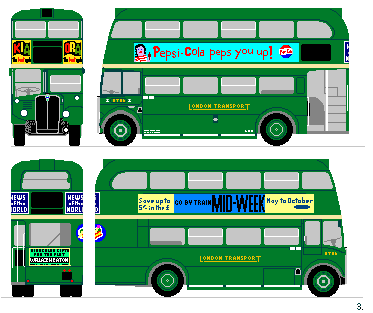 But seven were given a totally new lease of life.
RTs 36, 62, 79, 93, 114, 128 and 137 were overhauled in October 1954
Repainted in green and cream, and with the displays restored
(except the rear top-box) they went to Hertford (HG) in May 1955.
There they displaced saleable STLs on the 327
between Nazeing Gate and Broxbourne.
A weak bridge prevented the use of post-war RTs (UW 7-10-0),
but allowed the lighter, wooden-framed 2RT2s (UW 6-15-0).
For two years the magnificent seven worked the 327, until August 1957.
But seven were given a totally new lease of life.
RTs 36, 62, 79, 93, 114, 128 and 137 were overhauled in October 1954
Repainted in green and cream, and with the displays restored
(except the rear top-box) they went to Hertford (HG) in May 1955.
There they displaced saleable STLs on the 327
between Nazeing Gate and Broxbourne.
A weak bridge prevented the use of post-war RTs (UW 7-10-0),
but allowed the lighter, wooden-framed 2RT2s (UW 6-15-0).
For two years the magnificent seven worked the 327, until August 1957.
They had company at Hertford in the shape of red RT30 - a long-term Country Area trainer,
and for two periods red RT133, which was officially a spare staff bus,
but had a passenger license that was occasionally put to use,
making this the last RED 2RT2 to see passenger service for London Transport.
After August 1957 the seven green buses were put into store at Potters Bar,
and then became became trainers - some with the Country Area,
and some in Central area, retaining their green livery.
One of them, RT79, was the last trainer to be phased out, from Dunton Green (DG),
in February 1963.
RT113 recreated the 327 route between Hertford Bus Station and Nazeing Gate during the Running Day in June 2002.
It is seen in the much-modernised Hertford Bus Station, passing RT2083, and at the rural terminus next to the pond at Nazeing Gate.
The ex-staff buses, plus the green seven, soldiered on as trainers before the axe finally fell at the start of 1963. In January and February the orders went out, and the L plates were hung up for good.
Preservation
At least three survived into active preservation in the UK: RT 44, 54, and 113. RT113 is currently active.RT106, latterly turnover trainer 1036TV, was acquired for its chassis once its days with LT were finally done.
Others are or were preserved abroad, eg RT8 in St Louis (USA) and RT82 in Boston (Mass. USA). RT8 has now been brought back to the UK for the Ensignbus Museum.
Where is RT138? - or what happened to it?
Early days of preservation: RT44, with white upper-deck window surrounds, then RT54, with painted-over destination panels, leave the June rally at Stratford in 1970. Photos by Ian Smith. Click for larger version.

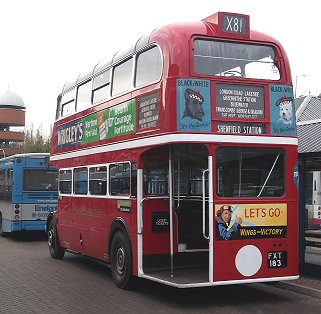
Rt8 was in service on the Ensignbus classic bus Running Day on 1st December 2012. Here it is on the X81 at Lakeside.
![]()
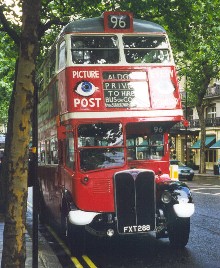
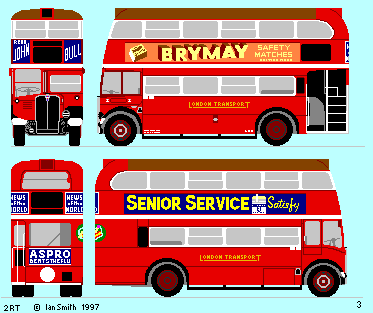
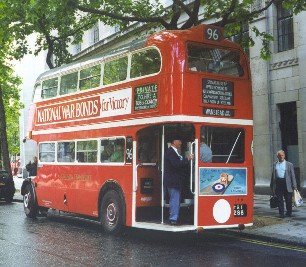
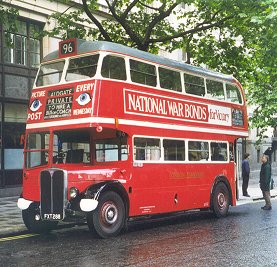
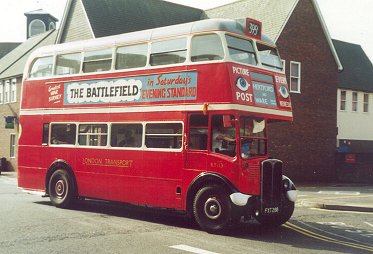
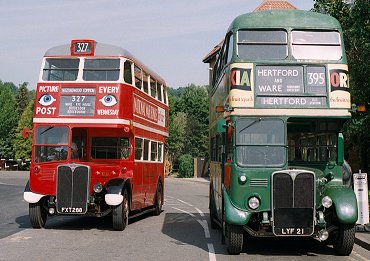
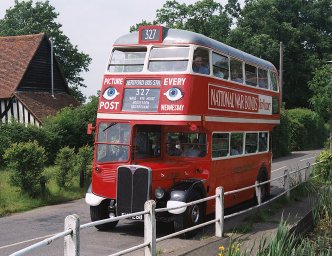
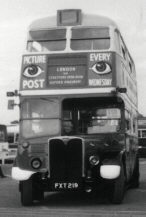
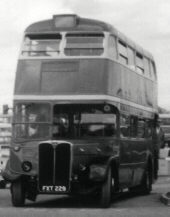
 RT97 and RTC1
RT97 and RTC1 Bus Stop
Bus Stop RT Contents
RT Contents RT1
RT1 prewar RTs
prewar RTs